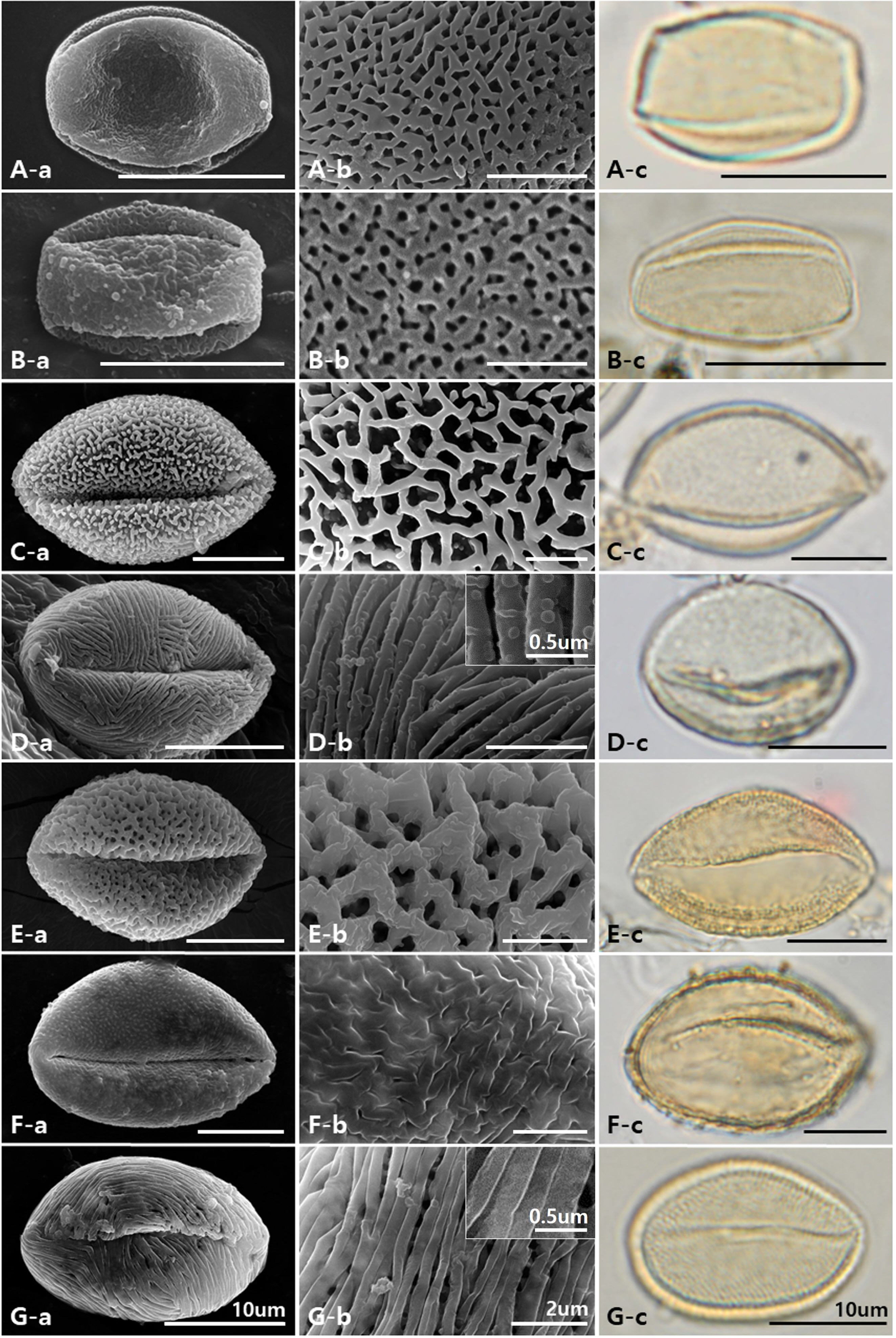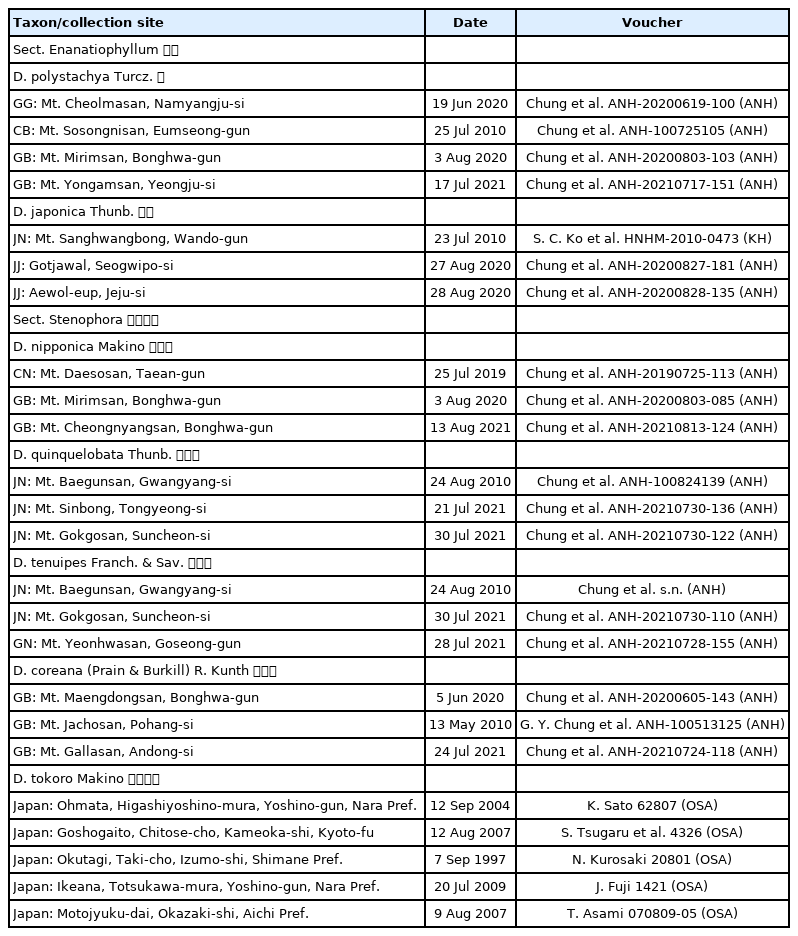A palynological study of Dioscorea (Dioscoreaceae) in Korea
Article information
Abstract
A palynological study of genus Dioscorea L. in Korea was conducted to evaluate the taxonomic implications. As a result of confirming the palynological characteristics of seven taxa of Dioscorea L., including six that are distributed in Korea and D. tokoro found in Japan, sections or species were classified according to the characteristics, such as the number of apertures, the polar end shape, and exine sculpturing. Specifically, the exine sculptures of D. coreana and D. tokoro, erroneously known to be distributed in Korea, are distinguished. The change in the number of apertures is closely associated with microsporogenesis, and it can be presumed that disulcate pollen might have been derived from monosulcate pollen in Dioscorea.
INTRODUCTION
The genus Dioscorea is the largest genus in the family Dioscoreaceae, and approximately 600 taxa can be found in tropical regions, East Asia, along Mediterranean coastal areas, and in South and North America (Coursey, 1969; Li et al., 1978; Ohwi, 1984; Im, 2000; Mabberley, 2005; Lee, 2006). Although most taxa are unisexual, a rare few are bisexual. There are six stamens, but three have degenerated in certain taxa, while in others, three loculi in the ovary develop into wings and two flat seeds with wings from the bracteole developed in one loculus. Based on these characteristics, genus Dioscorea can be distinguished from neighboring genera, such as Rajania and Tamus (Ding and Gilbert, 2000).
The genus Dioscorea in Korea is known to be distributed into eight species (D. polystachya Turcz., D. japonica Thunb., D. nipponica Makino, D. quinquelobata Thunb., D. tenuipes Franch. & Sav., D. tokoro Makino, D. septemloba Thunb., D. bulbifera L.) (Lee, 2003; Lee, 2006; Oh and Lee, 2007). However the distributions of D. septemloba and D. bulbifera are unclear in Korea, though the identity of D. coreana has recently been confirmed (Chung and Chung, 2015; Jeong et al., 2020).
It is difficult to classify the species due to the similar external shapes and great variation, but the pollen morphology of Dioscorea is recognized as an important taxonomic characteristic to distinguish the section and species of Dioscorea (Su, 1987; Schols et al., 2001, 2003, 2005). The pollen is medium-grained, with one or two apertures and perforate, striate, or microreticulate exine sculptures (Huang, 1972; Viruel et al., 2010; Daniel, 2011). Su (1987) classified 33 taxa and five sections of Dioscorea, including D. nipponica and D. tenuipes, based on characteristics such as the shape and size of the pollen and the number of apertures. Schols et al. (2001) conducted a palynological study of 35 taxa of Dioscorea, classifying sections and species of each taxon according to their morphological characteristics, including the pollen size, aperture, and exine sculpturing, while also explaining the relationship between each section based on external morphological characteristics. Later, Schols et al. (2003, 2005) added another 26 taxa to the original study, presenting the taxonomy and the genetic relationships of Dioscorea also based on pollen characteristics.
There are no data pertaining to palynological studies of Korean Dioscorea, including domestic D. polystachya and D. quinquelobata, apart from work by Chang (1986). Additionally, Jeong et al. (2020) re-identified D. coreana Prain & Burkill from its previously mistaken identity of D. tokoro (Lee, 2003; Chung and Chung, 2015). In relation to this, the present study evaluates specifically the taxonomic implications as part of a comparison with the pollen of D. coreana and D. tokoro, erroneously considered to be distributed in Korea and to be distributed in China and Japan (Ding and Gilbert, 2000; Yamashita and Tamura, 2016). A key of palynological characteristics is also presented.
MATERIALS AND METHODS
The materials used in this study were taken from herbarium specimens from the ANH (Andong National University Herbarium), KH (Korea National Arboretum Herbarium), and OSA (Osaka Municipal Museum of Natural History). Specimen information regarding the samples is listed in Table 1. The pollen was extracted from fully bloomed flowers and treated as follows in a slightly modified version of acetolysis (Erdtman, 1971; Radford et al., 1974). The extracted pollen was placed inside a 15 mL conical tube and the acetolysis mixture (acetic anhydride : sulfuric acid = 9 : 1) was added, after which the mixture was placed in a water bath at 80°C for approximately 10 min. The sample was then centrifuged at 1,600–1,800 rpm and the supernatant was removed. Finally, the sample was rinsed twice with glacial acetic acid and once with distilled water and 30%, 50%, and 70% ethanol before being stored in 70% ethanol. To measure the shape and size of the pollen, a permanent preparation was created by taking a small piece of the sample, placing it on a glass slide, and then sealing it with glycerin jelly (Kaiser’s method) (Erdtman, 1971) before the sample dried. The sample was observed using an optical microscope (Olympus AX-70, Tokyo, Japan) and measured using a cursor generator (ver. 2.0, Tokyo Electronic Industry Co., Tokyo, Japan). Exine sculptures that had clearly visible apertures were subjected to observations and measurements. In order to examine the micro-characteristics of the pollen, a small amount of each stored sample was placed on a sample stand and left to dry fully at room temperature. The sample then underwent a gold coating process (thickness: 200–250 Å) using an ion sputtering device and the shape and surface pattern of the pollen were observed and recorded using a field emission scanning electron microscope (SEM) (Tescan; MIRA3 XMH, Brno, Czech Republic; 15 Kv; working distance; 15 mm).
RESULTS
The pollens of the genus Dioscorea were single grains, small to medium in size at 12.9–30.2 × 9.7–20.4 μm (polar length × equatorial diameter). The pollen shape was prolate at P/E (polar length/equatorial diameter ratio) values of 1.3–1.6. Moreover, the apertures were monosulcate or disulculate and exine sculptures were perforate, striate, reticulate, and regulate (Fig. 1, Table 2).

Photographs of pollen of Dioscorea. A. D. polystachya. B. D. japonica. C. D. nipponica. D. D. quinquelobata. E. D. tenuipes. F. D. coreana. G. D. tokoro. a, pollen shape from a scanning electron microscope (SEM), b, exine sculpturing by SEM, c, pollen shape from a light microscope
1. D. polystachya (마): The pollen size was 16.2–19.1 × 11.5–13.5 μm (polar length × equatorial diameter) and the pollen shape was prolate at P/E 1.40. The polar end shape was truncate, the apertures were disulcate, and exine sculpturing was reticulate. The sexine thickness was 1.0–1.2 μm (Fig. 1A, Table 2).
2. D. japonica (참마): The pollen size was 12.9–15.6 × 9.7–12.1 μm (polar length × equatorial diameter) and the pollen shape was prolate at P/E 1.31. The polar end shape was truncate, the apertures were disulcate, and exine sculpturing was reticulate. The sexine thickness was 1.0–1.2 μm (Fig. 1B, Table 2).
3. D. nipponica (부채마): The pollen size was 20.5–28.1 × 15.5–18.1 μm (polar length × equatorial diameter) and the pollen shape was prolate at P/E 1.45. The polar end shape was obtuse, , the apertures were monosulcate, and exine sculpturing was rugulate. The sexine thickness was 1.1–1.6 μm (Fig. 1C, Table 2).
4. D. quinquelobata (단풍마): The pollen size was 22.0–26.4 × 14.3–17.3 μm (polar length × equatorial diameter) and the pollen shape was prolate at P/E 1.52. The polar end shape was obtuse, the apertures were monosulcate, and exine sculpturing was striate, with micro-granules present. The sexine thickness was 1.1–1.7 μm (Fig. 1D, Table 2).
5. D. tenuipes (각시마) :The pollen size was 23.1–30.2 × 15.3–19.2 μm (polar length × equatorial diameter) and the pollen shape was prolate at P/E 1.6. The polar end shape was obtuse, the apertures were monosulcate, and exine sculpturing was reticulate. The sexine thickness was 1.1–1.74 μm (Fig. 1E, Table 2).
6. D. coreana (푸른마): The pollen size was 23.4–29.7 × 15.1–20.4 μm (polar length × equatorial diameter) and the pollen shape was prolate at P/E 1.48. The polar end shape was obtuse, the apertures were monosulcate, and exine sculpturing was perforate. The sexine thickness was 1.1–1.6 μm (Fig. 1F, Table 2).
7. D. tokoro (도꼬로마): The pollen size was 19.4–22.1 × 12.7–15.3 μm (polar length × equatorial diameter) and the pollen shape was prolate at P/E 1.49. The polar end shape was obtuse, the apertures were monosulcate, and exine sculpturing was striate, with micro-granules absent. The sexine thickness was 1.1–1.6 μm (Fig. 1G, Table 2).
A key to Korean Dioscorea according to its palynological characteristics
1. Aperture number one (monosulcate); polar end shape obtuse.
2. Exine sculpturing striate.
3. Micro-granules at surface present ····························· ·········································· D. quinquelobata 단풍마
3. Micro-granules at surface absent ······························ ··················································· D. tokoro 도꼬로마
2. Exine sculpturing perforate, reticulate or rugulate.
4. Exine sculpturing perforate or reticulate.
5. Exine sculpturing perforate ······ D. coreana 푸른마
5. Exine sculpturing reticulate ······ D. tenuipes 각시마
4. Exine sculpturing rugulate ·········· D. nipponica 부채마
1. Aperture number two (disulcate); polar end shape truncate.
6. Average polar length 16 μm or more ········· D. polystachya 마
6. Average polar length less than 16 μm ······· D. japonica 참마
DISCUSSION
The external morphology of the genus Dioscorea can be difficult to use to identify the taxa due to the similarity and severe variation in certain diagnostic characteristics, such as the leaves, flowers, and fruits (Kang et al., 1992; Oh et al., 1995). However, as a result of confirming the palynological characteristics of seven taxa of Dioscorea, including six that are distributed in Korea and D. tokoro, found in Japan, sections or species were classified according to certain characteristics, in this case the number of apertures, the polar end shape, the exine sculptures.
The number of apertures and the polar end shapes are diagnostic characteristics of the section in the Korean genus Dioscorea. Plants in sect. Stenophora (D. nipponica, D. quinquelobata, D. tenuipes, D. coreana, D. tokoro) have one aperture (monosulcate) and a truncated polar end shape, while those in sect. Enantiphyllum (D. polystachya, D. japonica) have two apertures (disulculate) and an obtuse polar end shape. The results of the number of apertures and the polar end shapes were consistent with a report by Schols et al. (2003). They displayed the polar end shape in sections Cryptantha, Enantiphyllum, and Brachystigma, showing it to be truncated and finding the section Stenophora to be obtuse.
Various exine sculptures including perforate, striate, reticulate, and rugulate types were observed in this study, and these were considered as good characteristics that enabled distinctions between species. While D. nipponica and D. quinquelobata have very similar external characteristics, the exine sculptures were observed to be rugulate in D. nipponica and striate in D. quinquelobata. D. coreana has been misidentified as D. tokoro due to their very similar external characteristics (Lee, 2003; Chung and Chung, 2015). Nonetheless, several differences between the two species were revealed by Jeong et al. (2020). Dioscorea coreana was distinguished from D. tokoro by the absence of a pedicel in the male flower, the green color of the tepal, and the shapes of the fruit and seed. In addition, the exine sculptures were observed to be perforate in D. coreana and striate in D. tokoro, and the size of the pollen of D. coreana was also confirmed to be larger than that of D. tokoro.
A change in the number of apertures is closely associated with microsporogenesis (Rudall et al., 1997), and when this occurs through the simultaneous formation of vesicles, it is a relatively easy to see variation (Caddick et al., 1998; Ressayre, 2001). As the number of apertures in the pollen increase, its surface area and frequency of contact with the pistil also increase (Zavada, 1983; Chanda et al., 1988). Furthermore, based on changes in distribution due to morphological characteristics observed in fossil samples of sect. Stenophora (Burkill and Perrier, 1950), it can be presumed that disulcate pollen might have been derived from monosulcate pollen in Dioscorea.
Acknowledgements
This study was supported by a research grant of Andong National University (2021).
Notes
CONFLICTS OF INTEREST
The authors declare that there are no conflicts of interest.


